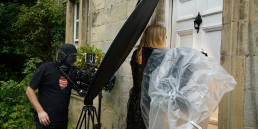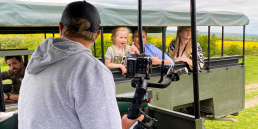When it comes to your marketing mix video remains one of the best tools in the box. With over one billion hours watched daily on YouTube alone (YouTube, 2020), and generating 49% more revenue growth than marketing strategies without (IMPACT, 2019), it’s something everyone really needs to do. However, this is only the case if you use the right content in the right way. Read below to get tips on maximising budgets and using your content the best way possible.
Yes, I’m sure Jane from accounts’ niece/nephew “can do some amazing things with their iPhone and gimbal thing”. But is this really the way you want to present yourself to the world?
The flip side of this is that doing video properly is not cheap. When you factor in the R&D, creative, writing and weeks of pre-production time, a crew of around 10 people, professional kit plus expenses, it soon adds up. Not to mention the editing, visual effects, audio mastering and grading that goes into post production. You are looking at weeks, even months, of work before you even think about distribution.
Now, the previous paragraph will raise alarm bells for a lot of people purely because of the implied costs involved. Irrespective of the increase in quality it brings. But what if I were to tell you, you could produce more effective quality content across all of your marketing for nearly the same cost as low budget disposable content?
It all comes down to getting the right help and planning ahead.
Most marketing strategies will span 6-18 months. However, when it comes to executing this plan it is often done ad-hoc. This way of working is hugely inefficient and can end up creating rushed, low quality content; using stock imagery or low budget productions based on its perceived importance. This way of thinking is a huge mistake. ALL your content should be of equal importance. If it’s not important, why are you doing it? Poor quality, unfocused content can be more detrimental than not doing it at all.
An example over 12 months
Let’s say throughout a year you want to use a modest content strategy of 1 video a month, plus 1 blog post and 2 social media posts per platform a week.
You could endlessly re-hash existing footage with a couple of still images to make half of this. Then throw in a handful of new talking heads. Commission some disposable animations with stock figures and invest in 1 or two “proper” videos on a budget.
Then you could do 4 photo shoots for specific applications (such as website content, company/product brochure etc). Then rely on stock or “borrowed” web images for the rest.
Let’s say you pay £2,000 each for 2 run and gun productions. £500 each for 4 animations and then £700 each for 6 edits (not including the cost of purchasing any stock footage). Then photography wise you pay your local photographer, or use stock, at an average of £50 per image (for a total of 24 images per shoot).
Thats a total of £15,000 spent throughout the year for content that is of varying styles and quality ranging from “that will do” to “ok”.
That £15,000 is a reasonable budget for a professional shoot spanning several days at the high production standard that was so alarming above.
By planning your content and rolling everything into a single shoot over a couple of days (and shooting video and photography together – ether in tandem or tag-team) you can create all the content you need at a far superior quality, and of a universal and succinct look, for use across every application for the rest of the year and beyond. Not to mention the internal time saved managing a single project, compared to juggling multiple across various suppliers.
Yes, this is a larger single investment compared to lots of little spends. However, if you speak to your content producers I’m willing to bet they will spread the cost over several payments. That way there is no difference to your cash flow. We do it.
Case Study
A great example of how this can work in practice is a project we finished earlier this year for Anantara Golden Triangle. Find out how we turned a single product commercial into an additional 9 videos with supporting photography for just a 20% increase in budget.

Ross Dixon
Creative Director
Related Posts
August 12, 2023
5 Proven Strategies to Maximise Your Video Advertising Results
With the advent of social media, and…
July 8, 2023
The Complete Guide to Hiring a Video Production Company in Newcastle
With the advent of social media, and…
June 4, 2023
8 things you should know before filming with animals
With the advent of social media, and…



